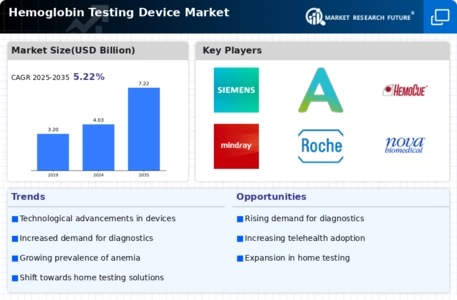Market Growth Projections
Rising Prevalence of Anemia
The increasing prevalence of anemia globally drives the demand for hemoglobin testing devices. Anemia affects millions, with estimates suggesting that around 1.62 billion people are anemic, particularly in developing regions. This condition necessitates regular monitoring of hemoglobin levels, thereby propelling the Global Hemoglobin Testing Device Market Industry. As awareness of anemia's health implications grows, healthcare providers are increasingly adopting these devices to ensure timely diagnosis and treatment. The market is projected to reach 4.03 USD Billion in 2024, reflecting the urgent need for effective anemia management solutions.
Government Initiatives and Funding
Government initiatives aimed at improving healthcare infrastructure and addressing public health challenges bolster the Global Hemoglobin Testing Device Market Industry. Various countries are implementing programs to combat anemia, particularly in vulnerable populations such as pregnant women and children. Funding for health campaigns and the distribution of testing devices in rural areas are becoming more prevalent. For example, initiatives in low-income countries focus on increasing access to diagnostic tools, which is expected to enhance the market's growth trajectory. Such efforts are likely to contribute to the market's expansion, with projections indicating a rise to 7.22 USD Billion by 2035.
Increasing Demand in Emerging Markets
Emerging markets are witnessing a surge in demand for hemoglobin testing devices, which is propelling the Global Hemoglobin Testing Device Market Industry. Rapid urbanization, coupled with rising disposable incomes, is leading to greater healthcare expenditure in these regions. Countries in Asia and Africa are particularly focused on improving their healthcare systems, resulting in increased investments in diagnostic technologies. The expansion of healthcare facilities and the introduction of public health programs aimed at reducing anemia prevalence are likely to further stimulate market growth. This trend indicates a promising future for the industry as it adapts to the needs of these burgeoning markets.
Growing Awareness of Preventive Healthcare
The rising awareness of preventive healthcare among populations worldwide is a key driver for the Global Hemoglobin Testing Device Market Industry. Individuals are increasingly seeking regular health check-ups, including hemoglobin testing, to monitor their health proactively. This trend is particularly evident in urban areas, where health education campaigns emphasize the importance of early detection of conditions like anemia. As consumers become more health-conscious, the demand for accessible and efficient testing devices is expected to rise. This shift towards preventive healthcare could significantly influence market dynamics, fostering a more robust growth environment.
Technological Advancements in Testing Devices
Technological innovations in hemoglobin testing devices significantly enhance their accuracy and efficiency, contributing to the growth of the Global Hemoglobin Testing Device Market Industry. Newer devices utilize advanced methodologies, such as microfluidics and non-invasive techniques, which improve patient experience and reduce testing time. For instance, portable devices that provide instant results are gaining traction in both clinical and home settings. These advancements not only facilitate better patient outcomes but also expand the market's reach, as healthcare facilities increasingly invest in modern testing solutions to meet rising demands.





















